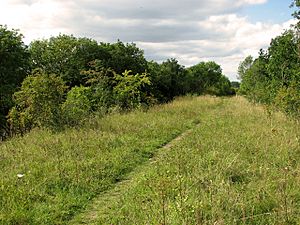Narborough Railway Line facts for kids
| Site of Special Scientific Interest | |
 |
|
| Area of Search | Norfolk |
|---|---|
| Interest | Biological |
| Area | 7.9 hectares (20 acres) |
| Notification | 1989 |
| Location map | Magic Map |
The Narborough Railway Line, also called the Narborough Railway Embankment, is a special nature reserve in Norfolk, England. It covers about 7.9 hectares (19.5 acres) and is a Site of Special Scientific Interest because of its amazing wildlife.
This area was once part of a railway line. Now, it is a peaceful nature reserve looked after by the Norfolk Wildlife Trust. You can find it about 1 kilometre (0.62 miles) south of Narborough. It is located near the A47 road, which goes from King's Lynn towards Swaffham. There is a car park west of the reserve where you can enter. People first wrote about this area in 1847, noting its chalk and flint rocks.
Contents
The Ground Beneath: Chalk Grassland
The land at Narborough Railway Line is made of a special type of soil called chalk grassland. This kind of grassland grew here after engineers from the Great Eastern Railway cleared the area. When they dug a borrow pit (a hole where material is dug up) next to the railway embankment, the chalk rock underneath was uncovered. This created the perfect conditions for the unique plants that grow in chalk grassland.
History of the Railway Line
The Lynn and Dereham Railway was a railway line that stretched for about 26.5 miles (42.6 kilometres). It connected King's Lynn to East Dereham, passing through Narborough and Swaffham. The plan for this railway was approved on July 21, 1845.
The railway opened in different parts between 1846 and 1848. Later, it became part of the larger Great Eastern Railway network. The first section to open was between King's Lynn and Narborough on October 17, 1846. The rest of the line was opened in stages by the East Anglian Railway, which took over from the L&DR. The entire East Anglian Line was ready by August 1847, after three and a half years of building.
The railway was first used by the post office to deliver mail across Norfolk. This railway line, which ran between Dereham and King's Lynn, was closed in 1960. It was part of the main line connecting King's Lynn to Norwich. In 1958, a man named Rod Lock became the first full-time stationmaster at Narborough Railway Line. He had to deal with tough weather, including severe blizzards in 1958 that even buried some trains!
Amazing Wildlife at Narborough
Narborough Railway Line is a fantastic place for wildlife. So far, 26 different types of butterfly have been seen here! In the summer, many birds visit the reserve. Sometimes, the reserve is closed to visitors when sheep are grazing on the site.
Birds You Might See
The most common birds you can spot here are the blackcap, chiffchaff, and common whitethroat. During the summer, you might even see turtle doves. In the colder winter months, look out for blackbirds, fieldfare, and redwing.
Plants and Butterflies Through the Seasons
In the spring and summer, the reserve is full of life. You might see butterflies like the grizzled skipper, brown argus, purple hairstreak, dingy, and grayling. Many beautiful plants also bloom, including eyebright, small scabious, kidney vetch, large thyme, marjoram, autumn gentian, and carline thistle.
As the year moves into autumn and winter, you can often find purging buckthorn plants, which are also very interesting.

